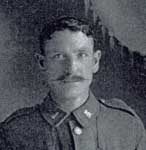 |
Remembrance
- The Yorkshire Regiment, First World War Corporal Arthur CURSON. 5381 Close window to return to main page |
 |
Further details on, and photos of, Corporal Arthur Curson are shown below.
Corporal Arthur CURSON
5381, 2nd Battalion Yorkshire Regiment. Killed 12 March 1915.
Born King's Lynn (Norfolk), Enlisted Warley, Resided Beverley (Yorks)
Commemorated Panel 12, LE TOURET MEMORIAL.
The story of Corporal Curson and his death at the Battle of Neuve Chapelle
was told by his great-grandson, Gavin Engelbrecht, in the "Northern
Echo" of 21 March 2002. We have been given permission to use this story,
below.
The story includes a photo of Arthur Curson and his family, and a letter written
by a fellow soldier which describes the circumstances of his death.
World War 1 Soldier in the 2nd Battalion
The following account from the "The Northern Echo"
of 21 March 2002 was written by Gavin Engelbrecht. March
is the anniversary of the First World War battle of Neuve Chapelle. Gavin
Engelbrecht traces the life of his great-grandfather who fell on the day
of the offensive.
Gavin also includes some very useful notes on how he
came to do the research into his great-grandfather's military career,
and how the Green Howards Museum was able to give him so much valuable help.
by Gavin Engelbrecht
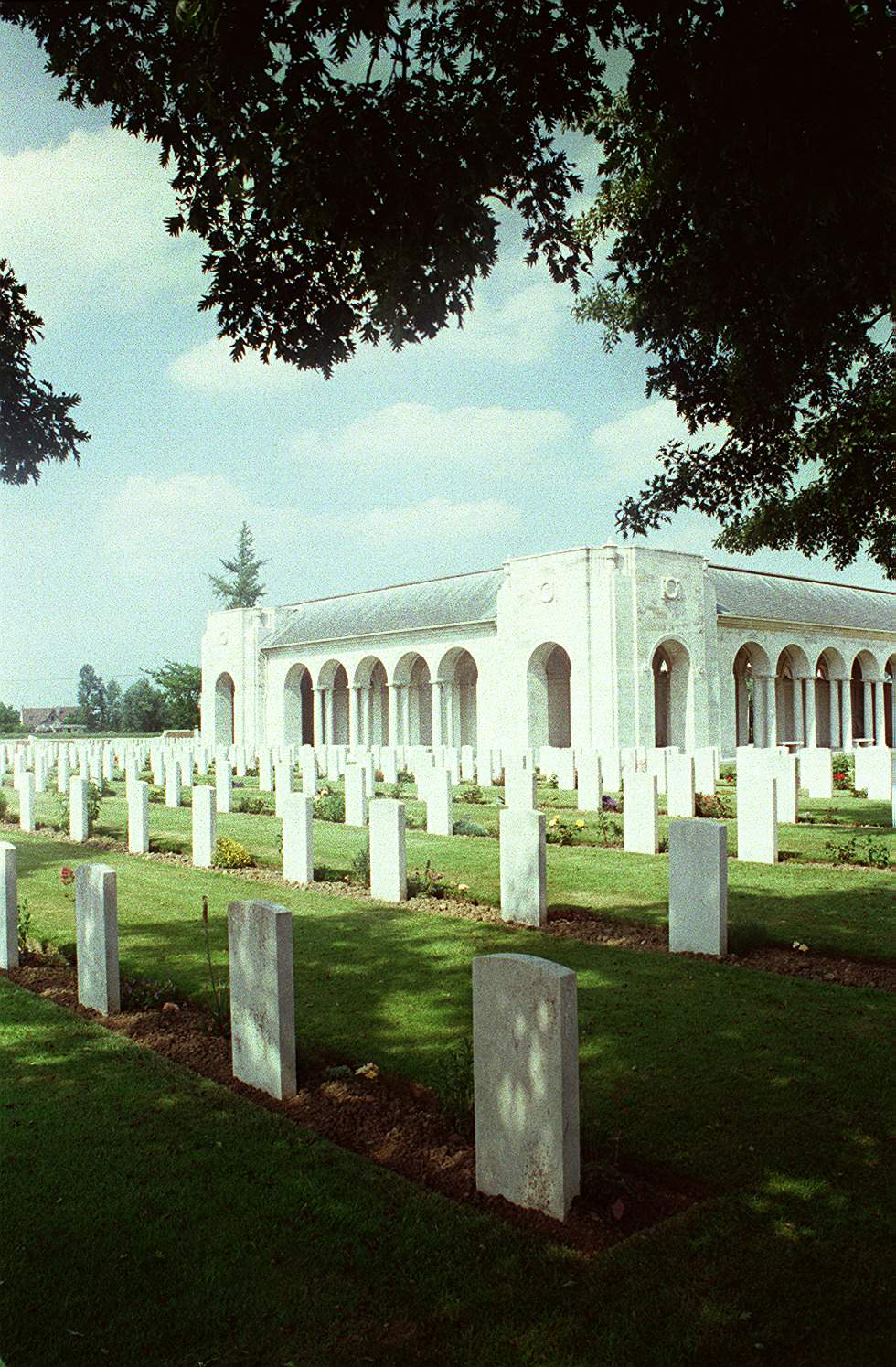 |
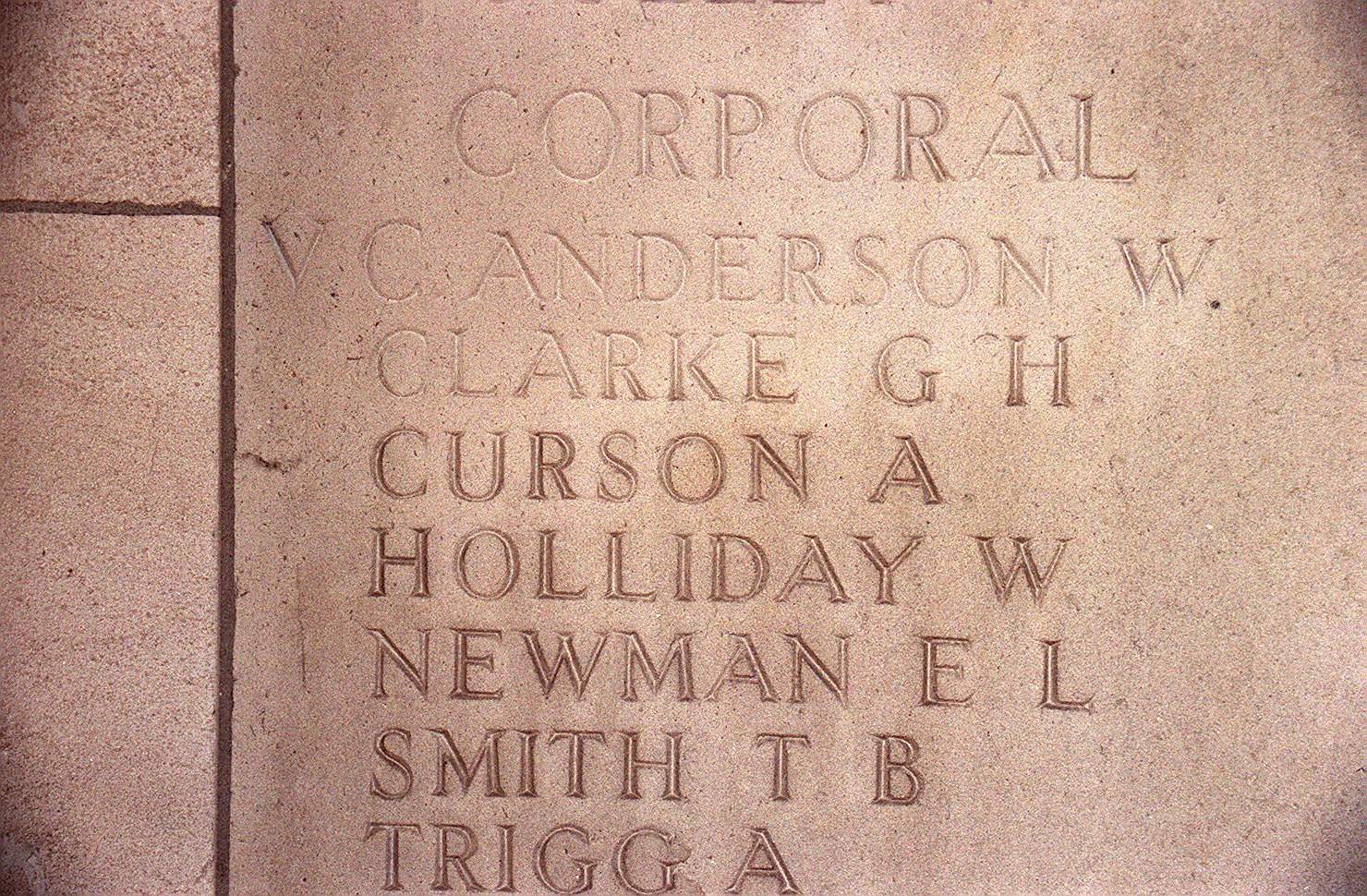 |
|
| The
Le Touret monument and the panel with Corporal Arthur Curson's name
carved on it. VC winner Cpl Anderson's name appears two names above
that of Cpl Curson. You may notice in the photograph that the stonework
is faded, -this is probably due to people taking rubbings off the
wall. |
||
SEARCHING the stark wall, I don't quite know how to respond. Panel after panel, each etched with the serried ranks of hundreds of soldiers' names, attest to the waste of war in this quiet corner of France. To comprehend the full enormity of the losses on just this one sector of the Western Front is impossible.
Here alone, at Le Touret monument, near Bethune, are recorded the names of more than 12,000 men who have no known grave. But the cold engravings become very personal as I spot the name of my great-grandfather, Corporal Arthur Curson.
Running my fingers along the chiselled letters, a warm surge of emotion overwhelms me as I experience a real connection with someone I never met - and yet having followed in his final steps, I feel I now know intimately. Standing back in silence and watching the clear blue sky through a crescent in the Portland stone monument, I feel a sense of accomplishment in the completion of a pilgrimage. And it is with a measure of pride that, as the first member of his family to visit the battlefield where his life was rudely taken by a mortar bomb, I find myself paying homage.
My thoughts go to his grief-stricken widow and two young daughters, who emigrated to South Africa - and I can't help reflecting that his sacrifice in a shell-pocked field in a corner of France was a small, but important, factor leading to my own existence.
What became a personal quest began as a mild curiosity as a child, when I learned that my maternal great-grandfather had died in the First World War. But then, didn't most families have a relative who died in the Great War, I thought? And so the matter rested until I moved from South Africa to North Yorkshire.
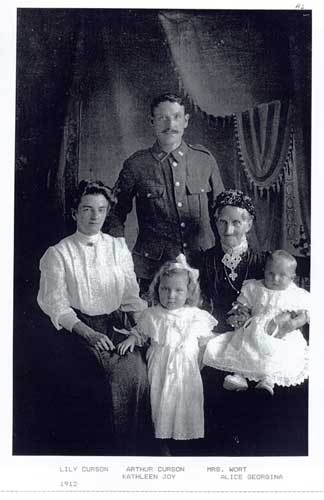
A photograph taken in 1912 showing Lily Curson, Arthur Curson,
Kathleen Joy Curson, Mrs Wort, and Alice Georgina Curson
(Click on the above image for a larger version that opens in a new window)
My interest was aroused by the fact that Arthur had served in the 2nd Yorkshire Regiment and had once lived in York. His biography was sketchy. Born in 1881 in Kings Lynn, Norfolk, Arthur grew up in an orphanage and enlisted as a bandsman at the age of 15.
Following a spell in India, the regiment spent two years in Cape Town, South Africa, where he met his wife Lily. Lily's family frowned on her relationship with a lowly soldier, but they eventually relented and gave their consent to marriage. The couple moved with the regiment to Fulford barracks in York, where my grandmother Alice and her sister were born, while Arthur doubled as Methodist lay minister at York's James Street Chapel. There the trail ran cold. Although a visit to York found the church replaced by a spare parts shop, I managed to trace Professor Kingsley Barrett, of Durham City, whose father had also ministered at the church.
I did not have to wait long to learn from him of a Mary Boler in Scarborough, whose parents briefly rented accommodation to Arthur's widow and children. Visiting a living link to the past and listening to her recall the "poor men" on a memorial in the church, further heightened my interest. A telephone call to the War Graves Commission and another piece of the jigsaw fell into place. Within seconds, I was told Arthur had died in action March 10, 1915, on the first day of the battle of Neuve Chapelle, and had no known grave.
And, with astonishing efficiency, I had the directions to Le Touret monument and where his name was recorded posted to me within a day. I finally had a time and place, but what of how he died? And then a letter emerged. Written in a neat copperplate hand from the trenches by a Private GH Sands, it brought home Arthur's last moments with a stark and haunting clarity.
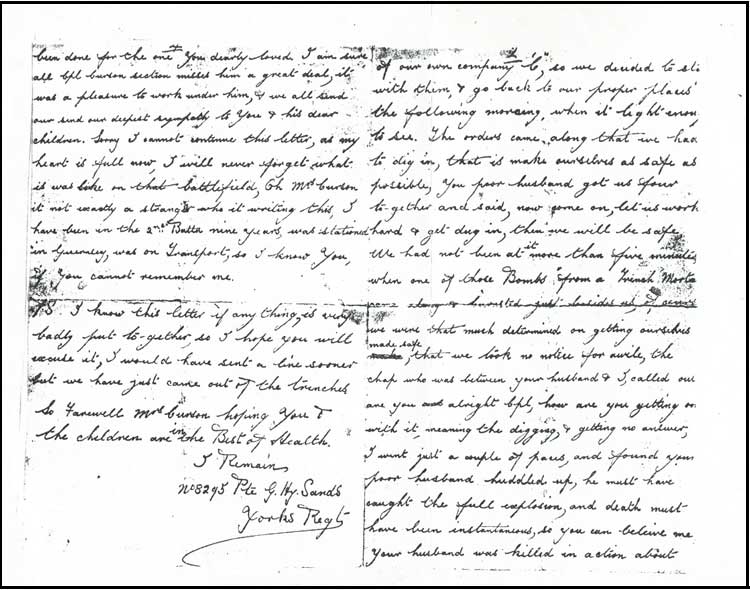
Private Sands' letter describing the circumstances of Arthur Curson's
death. A transcript of this letter is given below;-
Writing of the opening of the battle, Pte Sands wrote: "He (Arthur) was in charge of our section and we made our own advance at 3.30pm along with everybody. Everything went well until it got dark... the orders came along to dig in.
"Your poor husband got us four together and said, 'Now come on let us work hard and get dug in, then we will be safe'. We had not been at it more than five minutes when one of those bombs from a trench mortar came along and burst just besides us.
"Of course, we were that much determined on getting ourselves made safe that we took no notice for a while. The chap who was between your husband and I called out, 'Are you alright corporal, how are you getting on with it?' meaning the digging. And, getting no answer, I went just a couple of paces, and found your poor husband huddled up. He must have caught the full explosion and death must have been instantaneous."
The men were ordered to moved on, dig in and then move yet again. The next day the platoon was upset at not being able to find Arthur's body.
Private Sands wrote: "I would have liked to have taken his Bible and anything that you would treasure from him, but to have struck a match while we were in the battle would have meant death to all of us, besides it is strictly against orders.
"So as you can see, if it had not happened in the dark, everything possible would have been done for the one you dearly loved."
The last pieces in the jigsaw fell into place when I discovered that, as a member of a Yorkshire regiment, Arthur was a Green Howard. By an uncanny twist of fate, I found myself working directly opposite the Green Howards Regimental Museum in Richmond, where helpful museum staff opened their records, enabling me to trace his last months.
Armed with details of their daily dispositions, and with the added help of a detailed map from George Riordan, of Northallerton, whose father had served with Arthur, I set off to cycle the lanes he had marched along almost 90 years ago.
Last stationed in Guernsey, the 2nd Battalion landed at Zeebrugge, Belgium, to form part of the 7th Division on October 7, 1914. They were almost immediately thrown into battle at Ypres, where they held off the German advance - among their adversaries, one Adolf Hitler.
Having lost ten officers, and 655 other ranks killed and wounded, the remaining 300 men moved down to Ploegstreet and then Fleurbaix, where regimental diaries recount endless days improving trenches in rotting boots, brushwood fatigues and boredom, relieved only by shellfire and sniping. Their only small comfort was watching the Germans having to bail water out of their trenches as well.
The battle to take Neuve Chapelle began on March 10, 1915, with a massive artillery attack on a 2,000-yard front. The initial assault was a complete success, but the British attack lost momentum as communications broke down. And a massive German counter attack on March 12 brought the battle to an end, with British losses of 12,000 for no more than 2km of land. The battle was significant as it sowed the seeds in Field Marshal Haig's mind for what was to become the Battle of the Somme.
In an eerie postscript, as I cycled away, a documents file fell out of my saddlebag. Seconds after pulling off the road to pick it up, a heavy lorry thundered past, narrowly missing me. But it hit the file, sending paperwork flying. I was deeply upset to find a page of the Pte Sands' letter had vanished completely.
Not a believer in the supernatural, I found myself, however, wondering whether its loss was meant. Either way, a full circle had been completed, and I could return home in the knowledge that Arthur had not been forgotten and that his memory was assured.
Do you know what happened to Pte Sands? Contact Gavin Engelbrecht at Features, "The Northern Echo", Priestgate, Darlington, DL1 1NF, U.K.
------------->Return to the Top of the Page
Some Notes on How I Carried Out The Research Into This Story
Encapsulated in the following article is an account of my search for the facts about the life and death of my great grandfather, Corporal Arthur Curson.
While there are many things I could expand on I will confine myself here to aspects of my research.
Once I had obtained Cpl Curson's force number, I telephoned the War Graves Commission. I was amazed when, at the press of a button I was given details of when and where he had died. A day later, I got directions to the Le Touret memorial in the post - a service free of charge. Now, anyone with access to the internet can get this information immediately.
How Cpl Curson had died remained a mystery. But I was very fortunate to trace down a letter written by another member of his platoon detailing his death in action.
It was an incredible stroke of fortune, too, that I should have ended up working directly opposite the Green Howards Regimental Museum and Regimental Headquarters in Richmond, North Yorkshire.
As a journalist I was a regular visitor to the museum, but still had not realised Cpl Curson was a Green Howard.
It was while doing an article on a school visit to the museum, arranged so pupils could research details of their ancestors, that museum development officer Major Roger Chapman MBE entered Cpl Curson's name on the computerised record of the Dead of the First World War and told me the news.
The following day I got a letter from regimental secretary and museum curator Lieutenant Colonel Neil McIntosh MBE saying Pte Curson had gone to Belgium with the 2nd Battalion in October 1914 and was almost immediately involved in the First Battle of Ypres.
Lt Col McIntosh was able to tell me that by the time of Neuve Chapelle my great grandfather had been promoted to Corporal. And his force number indicated that he enlisted in the late 1890s.
He went on to wonder why, being a Norfolk man and having enlisted at Warley near Beverley in the East Riding of Yorkshire, he had not chosen to join the East Yorkshire Regiment instead.
I cannot thank Lt Col McIntosh and Major Chapman enough for the help they gave me in finding out more information about Cpl Curson. My thanks go as well to museum attendant Steve Rarity, who dug out regimental documents, war diaries, old Green Howards Gazettes, original trench maps and photographs for my benefit.
While they were not able to give me much more personal detail about Cpl Curson, by kindly granting me access to the regimental records, I was able to build up a vivid picture of the daily life of the 2nd Battalion.
Going through the war diaries also gave me an account of Cpl Curson's every move through Belgian and France, along with details of all the actions he was involved in.
Furthermore, Maj Chapman put me in touch with George Riordan of Northallerton, whose father Tom, had served with Cpl Curson and was captured by the Germans at the First Battle of Ypres.
Mr Riordan, a former major with the Royal Tank Regiment and PSO for the Green Howards in Harrogate, still conducts guided tours of the Ypres salient.
He kindly entrusted to me his personal Ordnance Survey map of the area, complete with annotations detailing the battalion's movements during the fateful battle.
The information gleaned with help from the museum staff and Mr Riordan's map made my trip all the more meaningful, - and I will remain indebted for their help.
One thing does still intrigue me. That is the fate of Private GH Sands force number 8295. His name is not recorded with the War Graves Commission, so I can only surmise he survived the war.
Gavin Engelbrecht
------------->Return to the Top of the Page
The Transcript of Private Sands' Letter
Dear Mrs Curson,
You will no doubt be very surprised to receive
this from me, but to make things clear I will explain to you that one
of your letters was brought to me by one of our stretcher bearers, and
he wanted to know if I could tell him if your dear husband was buried
or not. Well I could not say for sure if he was. I will try to explain
a few words to you as regards Corporal Curson. He was in charge of our
section and we made our own advance at 3.30pm along with everyone else.
Everything went well until it got dark, and what, with all the rushing
about your husband, two of our section and myself found that we had got
separated from our own platoon. Of course, we were with another platoon
of our own company C, so we decided to stay with them and go back to our
proper places the following morning, when it was light enough to see.
the orders came along that we had to dig in, that is make ourselves safe
as possible. Your poor husband got us four together and said, now come
on let us work hard and get dug in and then we will be safe. We had not
been at it more than five minutes whe one of those bombs from a trench
mortar came along and burst just besides us. Of course, we were that much
determined on getting ourselves made safe, that we took no notice for
a while. The chap who was between your husband and I called out are you
alright corporal, how are you getting on with it, meaning the digging.
And, getting no answer, I went just a couple of paces, and found your
poor husband huddled up. He must have caught the full explosion and death
must have been instantaneous. So you can believe me your husband was killed
in action at about 8pm on March 10, that is the first day of the battle
of Neuve Chapelle. The reason that we did not bury your husband is that
before we had finished our work we were ordered t move, dig at that place,
then we were moved again after that. And Mrs Curson, the night was awfully
dark, so after being moved twice, it was impossible to find the place
where our Corporal fell. Before leaving the firing line after the battle,
the three of us went to try and locate the place where your dear husband
fell, but we were very upset at not having found it. You may want to know
why we did not (indistinct) the trouble to take certain things from him.
Well, Mrs Curson, I think you will quite understand when I say we were
in a very awkward position. I would have liked to have taken his Bible
and anything that you would treasure from him, but to have struck a match
while we were in battle would have meant death to all of us, besides it
is strictly against orders. So as you can see, if it had not happened
in the dark, everything possible would have been done for the one you
dearly loved. I am sure all Corporal Curson's section misses him a great
deal. It was a pleasure to work under him, and we all send our deepest
sympathy to you and his dear children. Sorry, I cannot continue this letter,
as my heart is full now, I will never forget what it was like on that
battlefield, Mrs Curson. It is not exactly a stranger who is writing this.
I have been in the second battalion for nine years and was stationed on
Guernsey, was on Transport, so I know you, if you cannot remember me.
PS: I know this letter if anything is very badly put together, so I hope
you will excuse it. I would have sent a line earlier, but we have just
come out of the trenches. So farewell Mrs Curson. Hoping you and the children
are in the best of health.
no8295 Pte G Hy Sands, Yorks Regt.